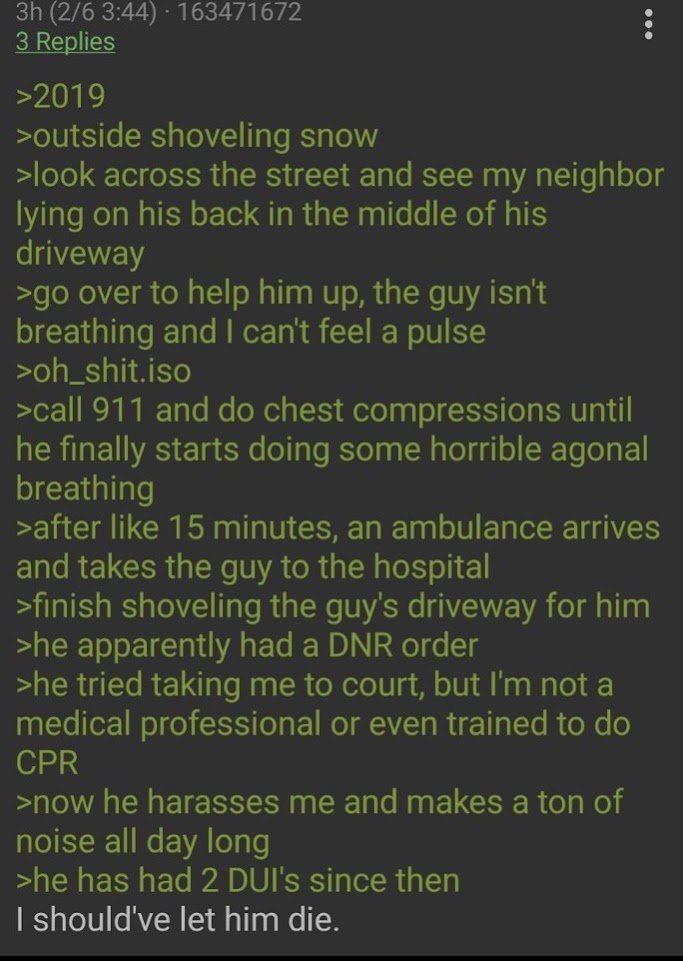this post was submitted on 09 Sep 2024
670 points (99.3% liked)
Greentext
3987 readers
1816 users here now
This is a place to share greentexts and witness the confounding life of Anon. If you're new to the Greentext community, think of it as a sort of zoo with Anon as the main attraction.
Be warned:
- Anon is often crazy.
- Anon is often depressed.
- Anon frequently shares thoughts that are immature, offensive, or incomprehensible.
If you find yourself getting angry (or god forbid, agreeing) with something Anon has said, you might be doing it wrong.
founded 11 months ago
MODERATORS
you are viewing a single comment's thread
view the rest of the comments
view the rest of the comments

My understanding was always that CPR isn't meant to revive someone its meant to keep them viable for revival by people with better training/equipment.
If you're really good at CPR they often regain consciousness while you are doing chest compressions and complain. Every time you pause, they die again
This is fucking hilarious
Its something alright.
How has this not been on tv yet? Lucifer would a done it if they knew it existed.
The way I heard it if they can't fight you off they still need CPR, so keep at it no matter what they say.
That ain't "being really good" - That's being stupidly lucky. I spent 20 years in the back of the bus, and I never had a revival on scene or in the rig. Nor did I ever meet anyone who ever made such a claim.
Quite often patients that are brought in with CPR in progress are called dead by the ER Doctor after another 20 or 30 minutes of effort or they do get a patient back and keep them going for another few days or a week or so. Only for the patient to finally die in hospital.
But, every so often someone surprises the hell out of us and actually survives and goes on to live for years. This is why we try as hard and as best we can to keep you alive. Because there is always a chance.
I'm just echoing the somewhat traumatising experience of a friend that works in a hospital. I'm gonna assume it's highly dependent on the nature of the injury requiring resus, both probability of survival and chance of waking up during CPR
Yeah, basically you're trying to force some circulation through the brain by manually pumping the heart - which is as much about clearing the waste buildup out of the brain as it is getting fresh oxygen to the brain, and also about preventing clots (which will later cause aneurysms when the blood starts flowing normally). Everything else is essentially expendable/repairable/replaceable.
Even the breathing part isn't very important, though the initial check to make sure the airway is clear is very important. If you're doing the chest compressions right, you'll force some airflow through the lungs anyway. The important part is getting the blood to circulate. Having stagnant blood sitting in the brain is really bad.
The current CPR procedure recommends 100-120 chest compressions of at least 2" (5cm) per minute. You are going to hurt them. You may crack their ribs. You need to compress the heart through their ribs and muscle and other tissue that's in the way. Even if you're in good physical shape, it is an exhausting thing to do. It's definitely something worth learning to do correctly - take a class if you can! You can absolutely save someone's life if their heart stops.
The class with a mannequin is really important to experience firsthand. Like to see that you should really start calling the emergency services and put them on speaker after you’ve assessed the situation and before you start CPR. And to know how hard you have to do it. It doesn’t take incredible skill, the modern mannequins will rate your performance, as long as you go fast enough and don’t stop it’s good. I was in shape at the time and I found it easy enough if you use your weight to help, I don’t think I could keep going hard for more than five minutes though.
That's why they recommended doing it in a group. You start getting tired, slowing down, not pushing down 5cm, etc so you hand off to someone else. It's a workout.
Now try doing CPR in the back of an amber-lamps bouncing down a gravel road at insane speeds while standing up and you have 50 miles, (80 Kms for those in Rio Linda) to the nearest hospital. Been there, done that, got way more tee-shirts than I ever wanted. Thank god for automatic CPR machines so I didn't need to manually do CPR for 40 minutes straight anymore.
I did CPR training a while back, including AED use. It was fun - and sobering. The takeaway was basically: the odds of your victim surviving this is low, but any chance is better than no chance. They also drilled into us that good CPR will likely crack some ribs. Which is again preferable to, you know, being dead.
They also had us training on two mannequins. First one was the ‘nice’ dummy that’s easy to compress and teaches good form. Then they switched it out for a ‘lifelike’ dummy, which supposedly simulates the actual strength needed for good CPR. And man, that’s a workout for sure. After performing five minutes of solo CPR on that bad boy, I was about ready to need that AED myself. I’m quite a chunky individual, and even leveraging my body weight that took a bit of strength. We had a petite girl in our class who couldn’t manage it.